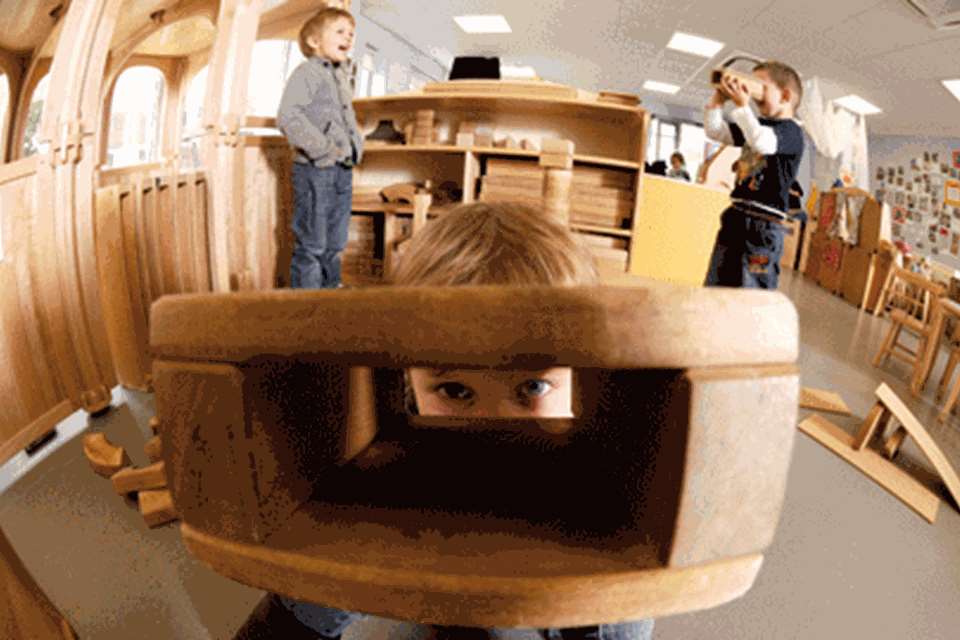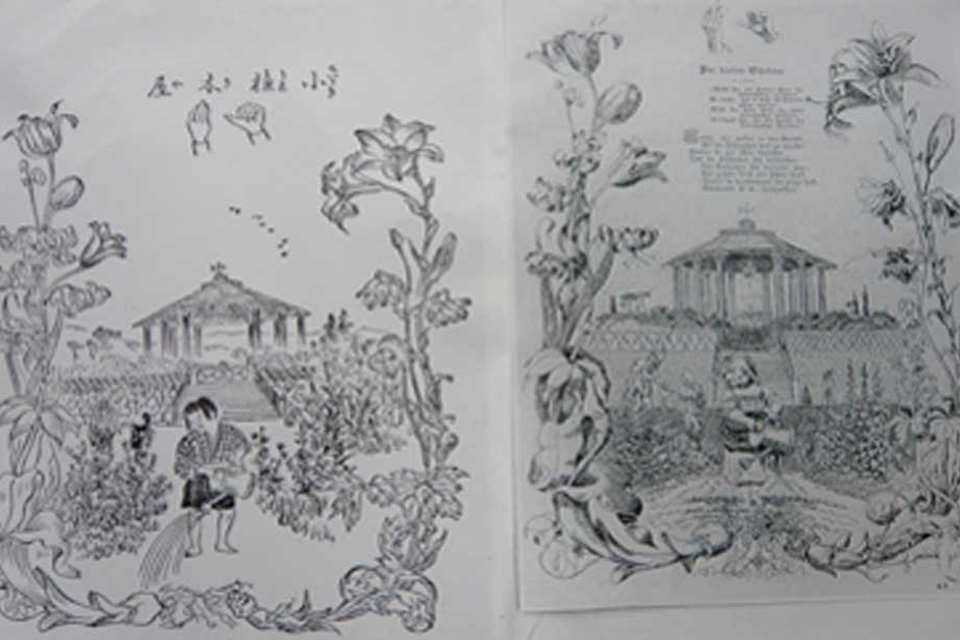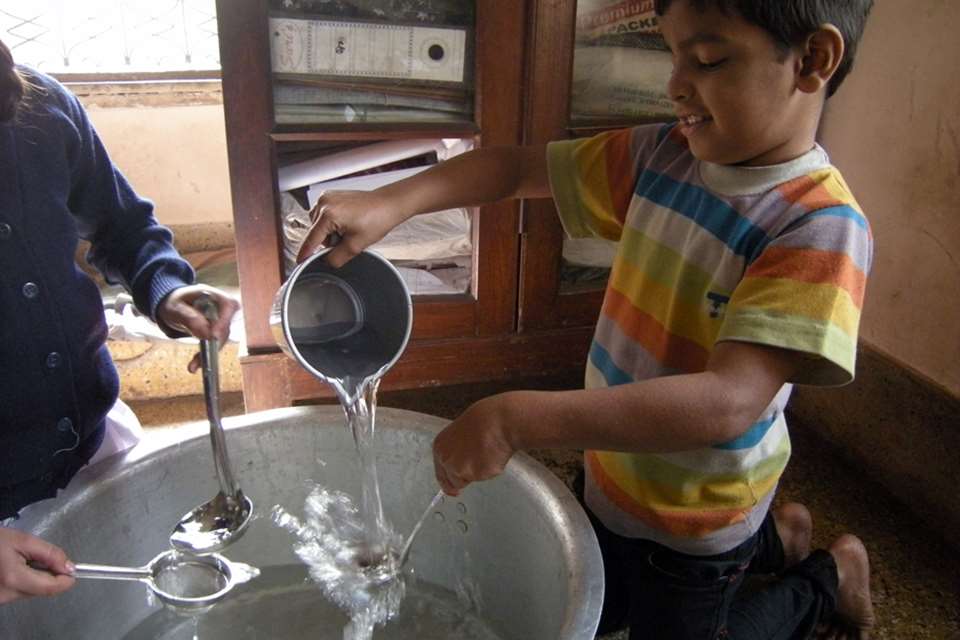EYFS Best Practice - Learning from Froebel… the Gifts
Professor Tina Bruce and Jane Dyke
Monday, January 23, 2017
In part one of their new series, Professor Tina Bruce explores ‘the Gifts’ and the theory behind them, while Jane Dyke reveals how this is being absorbed into the practice at her group, Yellow Dot Nurseries

ABOUT THIS SERIES
This six-part series aims to:
- convey Froebel’s continuing importance as an early years educator and thinker;
- make links between the EYFS and Froebel’s principles and approach to early development and learning; and
- demonstrate ‘Froebel in action’ at Yellow Dot Nurseries, Hampshire, which piloted training courses designed to help PVI settings embrace the Froebelian approach.
Co-written by Froebelian expert Professor Tina Bruce and Yellow Dot founder and owner, Jane Dyke, the six articles will cover:
- the Gifts
- the Occupations
- the place of nature in learning
- the symbolic life of the child
- the importance of nurture
- self-discipline rather than extrinsic motivation.
Linked to the series is a set of posters produced in association with Community Playthings (www.communityplaythings.co.uk), which will be taking part in this year’s bicentenary celebrations of the founding of Froebel’s school in Keilhau, Germany.
By Professor Tina Bruce
Much of Froebel’s philosophy of education can appear arcane and anachronistic to today’s early years practitioners, but its influence permeates the EYFS. That is true of his Gifts, six sets of cubes, spheres and cylinders, which are not widely used today but ‘live on’ in the hollow and unit blocks that are a staple of early childhood provision.
The Gifts are central to Froebelian practice and, like block play, enable children to make connections in their learning – building on the familiar, exploring the different and so expanding their skills, knowledge and understanding. Froebelians still say, ‘Link, always link.’
LEARNING
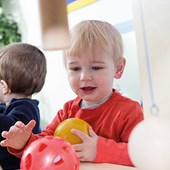 In each Gift we can see what Froebel calls the Law of Opposition. The soft sphere feels different from the hard wooden sphere, but there is connection between them, as they both roll. So does the cylinder, but it has flat surfaces which link to the flat sides of the cube. The cube does not roll, but when spun on a string it turns into a rounded shape. So, each Gift is in opposition to another Gift, but they all link to each other in important, unifying ways. This means children are encouraged to build on what is familiar and known, while challenged to explore differences and so to expand what they know, understand and can do.
In each Gift we can see what Froebel calls the Law of Opposition. The soft sphere feels different from the hard wooden sphere, but there is connection between them, as they both roll. So does the cylinder, but it has flat surfaces which link to the flat sides of the cube. The cube does not roll, but when spun on a string it turns into a rounded shape. So, each Gift is in opposition to another Gift, but they all link to each other in important, unifying ways. This means children are encouraged to build on what is familiar and known, while challenged to explore differences and so to expand what they know, understand and can do.
PRINCIPLES
As everything in Froebel’s approach to education and family life connects, it is not possible to see the Gifts in isolation. They link to various crucial elements of Froebelian education:
Unity The Gifts were designed to make tangible the way that everything is connected and has unity – as is seen in the mathematical precision of Gifts 4-6. There is also unity in the Forms which span a child’s developing learning (see below).
Play Children were encouraged to play freely with the Gifts and get to know what they would do (balance, tip over, match, line up) or might be (a garden, house or cart).
The supporting adult Children are not left alone in their learning in a laissez-faire way. They are helped to learn. When presenting children with the Gifts, the adult would introduce the language and talk, with the child, about the concepts that relate to each.
The Forms Froebel intended the blocks for children to represent:
- forms of life, using the blocks to create and represent things and events in the world around them, such as houses, tables, shops, roads, animals and trees;
- forms of beauty, where the focus is on the appealing quality of the patterns, order, symmetry, the look of creations, and how the whole relates to the parts;
- forms of knowledge, exploring the three-dimensional world, mathematical forms and scientific concepts such as shape, size, area, stability, balance, but also architecture, engineering, storytelling, the arts and other disciplines.
Freedom with guidance Froebel believed that children should be respected and taught respect for materials and each other, and with that respect should be given the freedom to choose, explore, create and so have control of their learning.
THE GIFTS TODAY
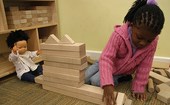 The original gifts fell from favour because they started to be used in increasingly adult-led ways and introduced as a rigid sequence, so depriving children of revisiting earlier Gifts. They were also linked to metaphors ill-suited to our more literal age – for example, the sphere was the universe. The best-quality unit and hollow blocks of today share the same mathematical relationships, but we can still use the Gifts to inform current early childhood practice:
The original gifts fell from favour because they started to be used in increasingly adult-led ways and introduced as a rigid sequence, so depriving children of revisiting earlier Gifts. They were also linked to metaphors ill-suited to our more literal age – for example, the sphere was the universe. The best-quality unit and hollow blocks of today share the same mathematical relationships, but we can still use the Gifts to inform current early childhood practice:
Many nurseries offer only group sets of blocks, but Froebel believed each child and practitioner needed their own set of Gifts. These would link with each other as a whole at the end of the session and the emphasis was on sharing ideas rather than actual blocks. So, we need to remember the benefits of a child exploring an idea alone using mini-blocks, as well as from collaborative group block play.
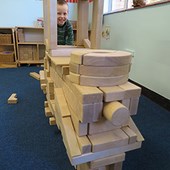 Froebel lived in Germany pre-decimalisation, when the base number was eight (not ten). So, the Gifts, and blocks, present the basic unit, half, quarter and eighth in a visible, tangible way, making it easier to experiment with fractions, division and symmetry.
Froebel lived in Germany pre-decimalisation, when the base number was eight (not ten). So, the Gifts, and blocks, present the basic unit, half, quarter and eighth in a visible, tangible way, making it easier to experiment with fractions, division and symmetry.
Froebel thought it essential to introduce the mathematical language of 3D shapes (sphere, cube, cuboid, prism) early as we live in a 3D world, and this would help understanding of 2D geometric shapes (circles, triangles, squares, rectangles).
The unity and interconnectedness of a whole set of blocks is hard to keep hold of in the way the modern blocks are stored. So, they need to be well presented and, at the end of the day, either sorted by shape or arranged carefully in a lidded box.
TRAINING
This anniversary year will see the launch of a unique modular Froebel course delivered around England by experienced peripatetic trainers. The course aims to increase Froebelian knowledge, heighten commitment to Froebelian ideas and change the way practitioners work with children. The course was developed with Yellow Dot Nurseries, which reports that, as a result, ‘we have focused on our resources, environment and adult interactions becoming more open-ended’. More information on this course will be available from The Froebel Trust at www.froebel.org.uk and office@froebeltrust.org.uk.
THE GIFTS
The six Gifts were designed to be introduced sequentially to young children, who played freely with them alongside a supportive adult.
 1. Comprising soft and coloured spheres on a string, this Gift was introduced to babies and toddlers and used to create different forms and shapes. Alongside, babies were also shown spheres in nature, such as (almost) spherical apples, blueberries and peas.
1. Comprising soft and coloured spheres on a string, this Gift was introduced to babies and toddlers and used to create different forms and shapes. Alongside, babies were also shown spheres in nature, such as (almost) spherical apples, blueberries and peas.![]() 2. With the second, the wooden sphere, cylinder and cube all hanging by string from a bar, or separately dangling from the hand, can be spun to create different shapes.
2. With the second, the wooden sphere, cylinder and cube all hanging by string from a bar, or separately dangling from the hand, can be spun to create different shapes.![]() 3. Comprised of eight cubes of equal size, which fit into a cube-shaped box with a sliding lid. Here, Froebel would flip the blocks out of the box as a single cube, as sand from a bucket when making a sandcastle.
3. Comprised of eight cubes of equal size, which fit into a cube-shaped box with a sliding lid. Here, Froebel would flip the blocks out of the box as a single cube, as sand from a bucket when making a sandcastle.![]() 4-6. In these sets, the boxes remain cube-shaped but the contents are cuboids and prisms, which relate mathematically to form a whole.
4-6. In these sets, the boxes remain cube-shaped but the contents are cuboids and prisms, which relate mathematically to form a whole.
![]()
![]()
MORE INFORMATION
The Gifts
Brosterman N (1997) Inventing Kindergarten. Harry Abrams
Liebschner J (2001) A Child’s Work: Freedom and Guidance in Froebel’s Educational Theory and Practice. The Lutterworth Press
Lilley I (1967) Friedrich Froebel: A Selection from his Writings. Cambridge University Press
Tovey H (2016) Bringing the Froebel Approach to YourEarly Years Practice. 2nd edition. Routledge
Block play
Bruce T (2012) Early Childhood Practice: Froebel Today. Sage
Bruce T (2015) Early Childhood Education. 5th edition. Hodder Education
Bruce T (2011) Cultivating Creativity: ForBabies, Toddlers and Young Children.Hodder Education
Community Playthings (2015) Foundations: The Value of Unit Blockplay(a free 30-minute video), www.community playthings.co.uk
Gura P (Ed) (2002) Exploring Learning: Young Children and Blockplay. Paul Chapman Publishing
IN PRACTICE
By Jane Dyke
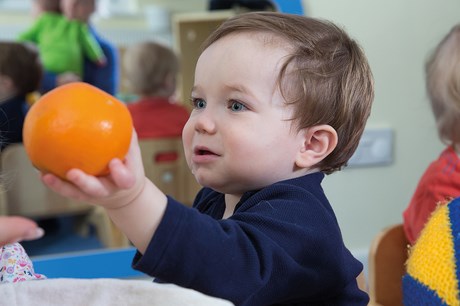
After our first day’s introduction to Froebel and his Gifts, we reflected on our own practice. We were encouraged to think that the Froebel approach is just that, an approach, rather than a method. Resounding in our ears and resonating in our hearts was ‘Freedom with Guidance’: providing a rich play environment that is meaningful, supportive and allows children to keep control of their own play. The Froebelian approach also places a strong emphasis on rich first-hand experience, a challenging, open-ended play environment and informed, sensitive adult interaction.
We saw a strong link with the Engagement, Motivation and Thinking from the EYFS Characteristics of Effective Learning, and since undertaking the training we have seen children develop perseverance and concentration, willingness to think and solve problems, to use ideas from experience, to be able to modify them and learn from mistakes.
Similarly, children have developed sensitivity to others’ needs, a better awareness of their own and others’ space and an ability to negotiate and make compromises. This self-regulation, the ability to manage difficult emotions and impulses and to think before reacting is a key Froebelian principle.
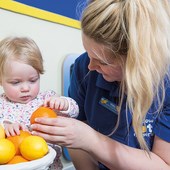 Froebel’s Forms of Life, Knowledge and Beauty have been our guide as we have reflected on changes or additions to our practice. As a result, we introduced a variety of soft spheres (Gift 1) to the baby rooms – knitted, crocheted and hand sewn, as well as bought. This was followed by hard spheres, based on Froebel’s idea of opposites. We hung spheres within Ikea crates and the children were fascinated by the movement. We went on to introduce ‘natural’ spheres; oranges, apples, walnuts. The older babies do have a set of small wooden blocks too, as well as packaging for posting, etc (tissue boxes are great for this, as are Pringles boxes).
Froebel’s Forms of Life, Knowledge and Beauty have been our guide as we have reflected on changes or additions to our practice. As a result, we introduced a variety of soft spheres (Gift 1) to the baby rooms – knitted, crocheted and hand sewn, as well as bought. This was followed by hard spheres, based on Froebel’s idea of opposites. We hung spheres within Ikea crates and the children were fascinated by the movement. We went on to introduce ‘natural’ spheres; oranges, apples, walnuts. The older babies do have a set of small wooden blocks too, as well as packaging for posting, etc (tissue boxes are great for this, as are Pringles boxes).
With our toddlers, we introduced 3D shapes through packaging and real opportunities for building, stacking and exploring the properties of shapes. Again, we also introduced natural shapes, particularly in our role play. We started to expand the Froebelian ‘Form of Knowledge’ by using 3D language – a challenge initially for our team members too!
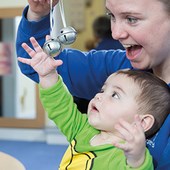 The Form of Beauty is tricky with the toddler age, but we have seen that they do respond differently to beautifully displayed provocations and can be encouraged (but never forced) to return their play items, when this is modelled by practitioners. They seem interested to see adults return things, observing the process even when not participating.
The Form of Beauty is tricky with the toddler age, but we have seen that they do respond differently to beautifully displayed provocations and can be encouraged (but never forced) to return their play items, when this is modelled by practitioners. They seem interested to see adults return things, observing the process even when not participating.
BLOCK PLAY
Block play today has been developed from Froebel’s gifts 2-6. Froebel believed that ‘all children have the desire to build and to build a house is a universal form of unguided play’ (1841). With our children over three, we have ensured that they have correct unit blocks, and the children have shown great co-operation in their play together, while investigating the mathematical qualities. (We were bewildered to discover that not all block sets are actually mathematically correct!)
Children use blocks in different ways, but there is often a pattern to how this develops. Very young children usually start by playing with them as individual pieces to explore and get used to the shapes and sizes. They begin to stack both horizontally and vertically, make bridges, slopes and enclosures as they move towards more complicated buildings and structures (see ‘Developments’ in box, overleaf).
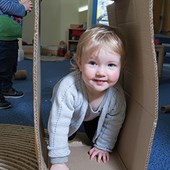 In a Froebelian approach, we should value children’s own play with blocks including recognising and enhancing schemas. We should interact sensitively; carefully observe and tune in to a child’s intentions; and actively listen and show interest and respect for children’s constructions rather than instruct, build structures for children to copy or impose adult–designed tasks. This relates to all areas of the Characteristics of Effective Learning.
In a Froebelian approach, we should value children’s own play with blocks including recognising and enhancing schemas. We should interact sensitively; carefully observe and tune in to a child’s intentions; and actively listen and show interest and respect for children’s constructions rather than instruct, build structures for children to copy or impose adult–designed tasks. This relates to all areas of the Characteristics of Effective Learning.
As with everything, Freedom with Guidance should be applied and clear basic rules be in place so that all children have the freedom to build but do not feel insecure due to a lack of boundaries.
Really rich block play does not just happen, the role of the adult is crucial. Froebel argued that we need a proper understanding of the learning potential of blocks and the developmental aspects of block play. Most importantly, we need to have a practical understanding of blocks, so play away yourselves to appreciate their possibilities!
Initially, we had a mixed reaction from our team about giving children control of their learning, but the training and Top Tips have helped the team feel more secure and allow the children to develop their play.
Since introducing the Gifts to our children we have noticed a different level of engagement in their play. The block play particularly has become a firm favourite and is in use most of the day. Froebel encouraged unity and respect and, as we have begun to embrace this, we can see the difference in our children and our practice.
BLOCK PLAY: YELLOW DOT’S TOP TIPS
FORMS OF LIFE
Recognise the extent to which children can make connections between their own life experiences and their play, can create things they have seen in the world around them, whether this is a car, a boat, a building, and can add stories to their play.
Remember too the lifelong skills that can be developed such as imagination, co-operation, problem solving, not giving up, negotiating, creativity and wonder.
FORMS OF KNOWLEDGE
Be aware of the range of learning that can occur in block play, and the opportunities it provides for children to answer their own questions (How can I build an arch? How can I make my tower more secure?):
Maths Pattern, fractions, symmetry, measurement, length, volume, sequence, counting, sorting, properties of the blocks (face, edge, corners, flat, curved, solid, 2D and 3D).
Science Balance, exploration, experimenting, discovery, gravity. Elements of engineering are also promoted.
Geography Making maps – of how to get to nursery or granny’s house, of the local community (using blocks to represent the library, supermarket, etc), looking at local architecture and recreating it.
Arts Building sculptures, looking at artworks, recreating and creating.
FORMS OF BEAUTY
Present the blocks beautifully either in the storage unit or carefully organised on shelves with templates to indicate where to return the blocks to the whole set. Returning the blocks to a Form of Beauty was also quite difficult initially and needed to be reinforced with both the team and the children. We used different strategies for babies and toddlers, where adults modelled returning the blocks with toddlers maybe joining in at times, whereas older children are expected to join in returning the blocks with the adults.
Children can explore pattern, harmony, symmetry and sequences using the blocks, so emphasise the beauty of these creations.
Encourage children to look at the beauty around them – the patterns of the bricks in a building, the shape of a bridge.
ADULT ROLE
Give children the time and space to explore the blocks independently so that they can develop their own ideas. We needed to reorganise our rooms to allow dedicated space for the blocks. Initially, we had a mixed reaction from our team about working in this way.
It is important to get the right balance between adult interaction and letting children find things out for themselves. This allows for the adult to model the thinking behind assembling different structures and the language associated with block play.
Observe the children, support them and extend their learning with careful interactions.
Link block play to books about architecture and buildings as well as linking to your local community. Use open-ended questions to support children in making these connections.
Provide a large space for uninterrupted play.
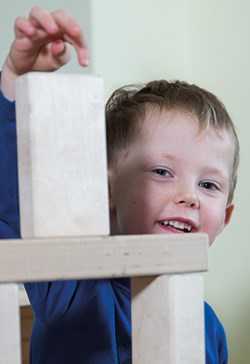 Developments in block play
Developments in block play
Familiarise yourselves with how children’s block play develops:
Pure explorations These earliest experiences of block play could include carrying around the blocks, emptying them all out of the storage unit, piling them up and knocking them down. The children are learning about blocks and what blocks can do.
Building begins The children explore what they can build. This may include building towers of differing heights, or building a road along the floor. This is when you may start to see the children using their imagination.
Enclosures Children may build to enclose something, maybe themselves or other props. Enclosures can be rounded in form or straight-edged.
Making arches Children begin to connect the blocks to make bridges and arches as they become more experienced. There is trial and error as the children begin to explore balance and hand-eye co-ordination.
Representational building This can include representing anything they have seen or experienced themselves which they can make with the blocks. The children may have been inspired by a story. This is where children learn about symmetry and patterns, balance and making their own designs. The children are able to follow their own interests and ideas, so it could be anything.
Complex buildings As children develop their wooden block play, making increasingly complex constructions, with arches and multiple levels, they learn co-operation and turn-taking skills, sometimes building structures together and sometimes concentrating alone. It is important therefore to have a lot of wooden blocks for the children to choose from.
ENHANCING BLOCK PLAY
It is a good idea to encourage children to construct first and enhance the play later. Their creations will often be more complex when you do this. The play can be enhanced by such resources as: small-world toys, fabric, smaller blocks, steering wheels, hats, scales, pulleys, pipes, empty food containers, dolls’ house furniture, magazines, photographs and books of buildings and structures.
OBSERVATION
Block play is a vitally important experience in early childhood settings, offering potent learning opportunities that span the early years curriculum. Observation is essential to help practitioners support and extend the children’s development and learning. It is also helpful to think about schemas when observing block play.



